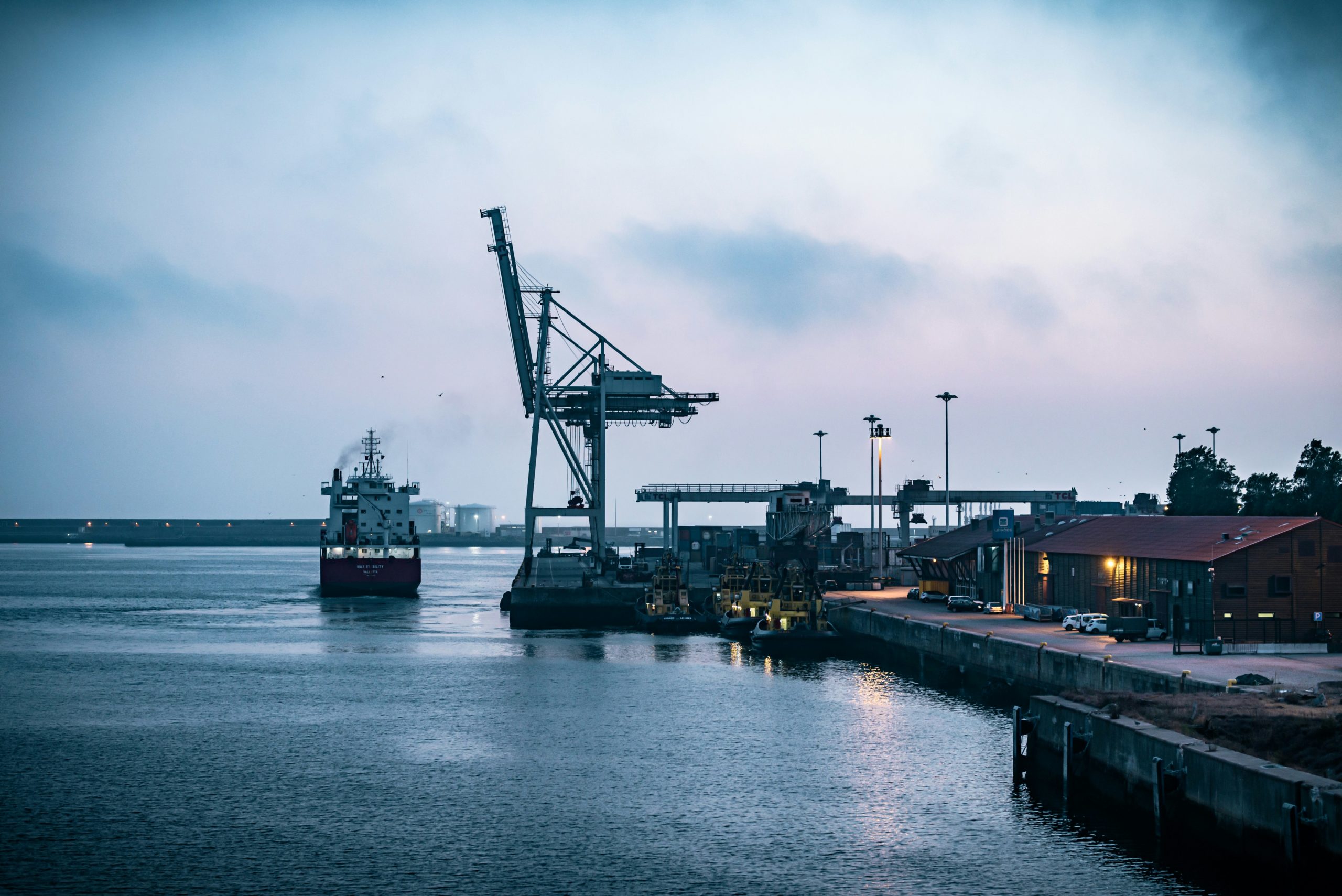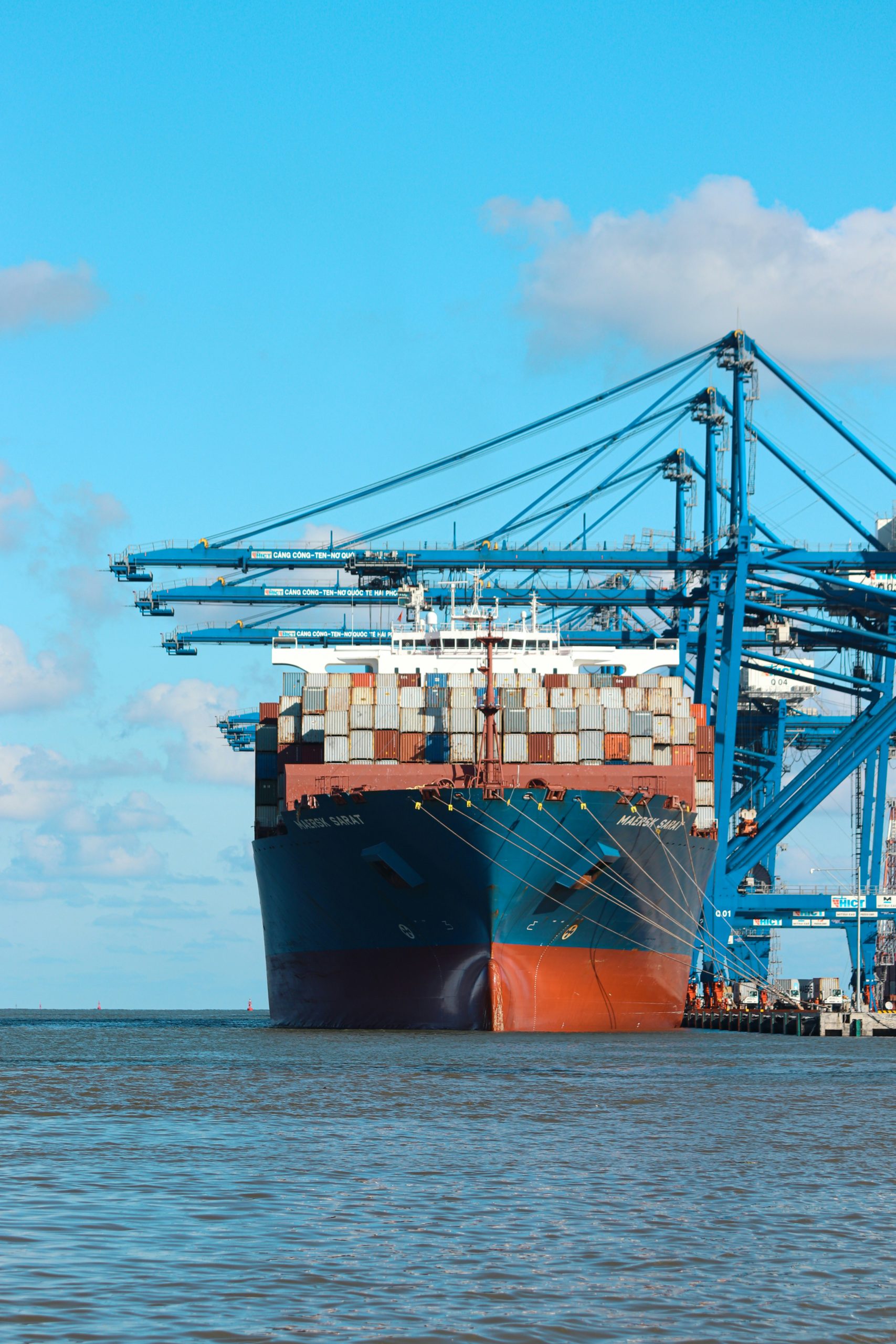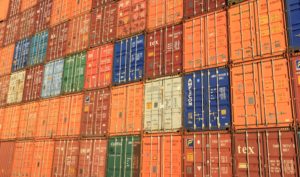Why is this important?
Over 80% of the volume of international freight is already transported by sea (1) However, despite the relatively low climate impact as compared to air freight, greenhouse gas emissions from sea freight account for almost 3% of global emissions, and keep growing (2). Over the past 10 years, maritime transport increased by 20% and is estimated to increase by 30% by 2050 compared to 2008 levels, if no action is taken (3). Despite a better efficiency of maritime freight energy use with larger vessels, globally 2,000 times more goods were transported in 2021 (1.95 billion tons) compared to 1980 (0.1 billion tons) (4).
The industry operates an ageing fleet, with nearly 98.8% of vessels relying exclusively on fossil fuels making carriers a challenge to decarbonise (5). Due to the long lifespan of vessels, there is urgency to start the transformation to a new generation of ships that can operate with the most efficient fuels and using the latest digital technology (6).
In addition to greenhouse gas emissions, sea transport is also responsible for sea pollution, sea life disturbance with noise and collusions, and invasive species migration (7).
What's the solution?
The environmental impact of the shipping industry can be reduced starting with limiting freight by optimising supply chain planning (incl. demand planning) and shipments, wherever possible. Organisations can already ask today for the use of alternative fuels with significant greenhouse gas emission reduction potentials (from approximately 80% with biofuels to nearly 100% with all-electric) (8). Organisations should also question their logistics service provider about their decarbonisation strategy and which operational measures they take to reduce the climate and environmental impact of maritime transport, such as reducing speed, optimising vessel utilisation, increasing energy efficiency and transitioning to more sustainable ships.
By building climate requirements into the procurement process, organisations do not only reduce the climate impact of their transport needs, but also support the transition by creating additional demand for more sustainable shipping services. Considering long-term contracts and reducing waiting time at anchoring are further actions organisations are encouraged to explore.
Keeping up to date with industry developments is key to being able to adapt an organisation’s strategy to latest innovations.
Point of attention
-
Point of attention
Sea freight has a much lower climate impact than air freight per tonne-km transported and should therefore be chosen as the default option. Air freight should be limited to sudden onset emergencies, air-mandatory products or other specific contexts that require air freight. See factsheet on switching to sea freight. Actions should also be taken to optimise resource use and planning to optimise purchases of items, thereby reducing both procurement- and transport-related emissions.
Key actions
-
#1 Optimise logistics to reduce mileage
Increase direct deliveries from suppliers to hubs/missions. Develop logistics platforms and warehouses as close as possible to the operating sites and optimise the entire supply chain to reduce mileage of transported goods. Mutualise shipments and containers with partners.
-
#2 Select offers that use alternative fuels
Request the use of alternative fuels from logistics service providers. See info box on alternative fuels.
-
#3 Use low-carbon transport providers
-
#4 Add climate criteria to the procurement process
Include a climate dimension into specifications and the RFI/RFP process. Add climate criteria to the evaluation process. Include climate requirements to contracts and monitor performance of suppliers. Refer to the Smart Freight Centre’s Procurement Playbook (17) for further guidance.
-
#5 Consider long-term contracts
The longer the contract, the more risks a ship owner can take, and the more they can invest in innovations and new solutions. Assess the possibility to conclude long-term contracts with logistics service providers, linked to specific climate commitments.
-
#6 Reduce wasted time and energy at anchorage
About 20% of maritime fuel consumption globally, is spent outside the port, waiting. There are systemic inefficiencies causing this, but initiatives such as BlueVisby looks at opportunities to share risk through digital and contractual innovation.
-
#7 Join collaborative networks
Participate in networks such as the Sustainable Freight Buyers Alliance or the Zero Emission Maritime Buyers Alliance.
-
#8 Stay up to date
The industry is moving fast and new solutions become available to the market fast. Stay informed about market developments to be able to adjust your strategy. Here a few ideas on organisations to follow: LR Maritime Decarbonisation Hub, Mærsk Mc-Kinney Møller Center for Zero Carbon Shipping, DNV Maritime Decarbonization and Smart Shipping Centre of Excellence.
Image

Infobox: Alternative fuels
-
Infobox: Alternative fuels
Alternative fuels for the use in maritime transport can be categorised into methane, methanol, hydrogen and ammonia as well as bio-oils. They can be produced either from biomass as a feedstock, using electrolysis, or carbon capture and storage. Alternative fuels are at different stages of technical and regulatory maturity.
The Mærsk Mc-Kinney Møller Center for Zero Carbon Shipping provides an overview of different alternative fuel options and their maturity levels in their Fuel Pathway Maturity Map. Lloyds Register Maritime Decarbonisation Hub’s Zero Carbon Fuel Monitor provides an overview of electrification and nuclear technology as well as of alternative fuels.
In addition to alternative fuels, battery-electric ships use stored electrical energy to power propulsion systems. They are suitable for short voyages and operations near equipped ports. These can achieve nearly 100% decarbonisation for short-distance shipping when using renewable energy, but are limited by current battery technology and infrastructure.
Liquefied Natural Gas (LNG) is a natural gas that has been cooled to liquid form for ease of storage and transport. It can reduce CO2 emissions by about 20% compared to traditional marine fuels, though methane leakage remains a concern. Natural gas remains a fossil fuel, and is therefore not recommended.
To consider
-
Potential co-benefits
- Financial savings from shipment reduction and optimisation
- Supporting the green transition of the maritime industry by requesting low-emission transport
-
Success conditions
- Policy measures to support the transition, e.g. investments in infrastructure, R&D, and incentives such as carbon pricing to make alternative fuels more competitive (18)
-
Prerequisites & specificities
- Alternative fuels availability (biofuels, hydrogen, electrofuels…) and efficiency (19)
- Global collaboration to further develop required infrastructure, green shipping corridors and designated routes for sustainable vessels
- Availability of second-generation biofuels (produced from wastes, residues and non-food biomass feedstocks)
- Climate-ready, efficient and digitally connected ports (20)
- Price, availability, maturity, scalability of low-carbon ships (fossil-free electricity, hydrogen, advanced bio fuels, green ammonia & methanol etc.) (21)
-
Potential risks
- Use of first-generation biofuels that are competing with food sources (grains, crops and vegetable oils) or that contribute to deforestation (22)
Tools and good practices
-
Procurement Playbook: Integrating sustainability in logistics services and procurement tenders, 2024
Smart Freight Centre procurement playbook improves procurement process, aligning it with sustainable logistics objectives, integrating sustainability into tendering and evaluation processes.
Explore here -
Transportation Action Guide from Exponential Roadmap Initiative, 2023
This guide develops the key recommendations from the 1.5°C Business Playbook on how to drastically reduce transportation Greenhouse Gas (GHG) emissions.
Explore here -
Free CO2 calculator for freight from Cargoson
Cargoson is a private company developing transport management software. They propose this free CO2 calculator to evaluate the greenhouse gas emission of freight.
Explore here -
European Maritime Safety Agency: Alternative Sources of Power, 2024
EU Maritime initiative, EMSA has produced a series of reports, studies, and guidance on alternative fuels and sources of power.
Explore here -
Green carrier: Sustainability Report, 2022
This sustainability report aims to set a benchmark for sustainable logistics in the market, encouraging competitors, suppliers, customers, politicians, and authorities to prioritize sustainability in their development efforts.
Explore here -
Zero Emission Maritime Buyers Alliance
The Zero Emission Maritime Buyers Alliance (ZEMBA) is a first-of-its-kind buyers group within the maritime sector with the mission to accelerate commercial deployment of zero-emission (ZE) shipping solutions, enable economies of scale for freight buyers and suppliers, and help cargo owners maximize emissions reduction potential beyond what any one freight buyer could accomplish alone.
Explore here -
Routes-based action plan: a toolkit, 2023
This report produced by the LR Maritime Decarbonisation Hub for the IMO NextGEN Connect-GreenVoyage2050 Project, presents a routes-based action plan methodology that is designed to kickstart the uptake of clean maritime fuels, and supports the inclusion of developing countries, Least Developed Countries (LDCs) and Small Island Developing States (SIDS).
Explore here
To go further
-
Climate Action Accelerator Webinar “How to reduce carbon emissions from maritime transport, 2024
This webinar provides an introduction into larger industry efforts to decarbonise maritime freight and presents concrete solutions on how organisations can already act today to reduce the impact of the maritime shipping of goods.
Explore here -
Strategy on Reduction of GHG Emissions from Ships, IMO, 2023
The International Maritime organisation publishes a strategy with measures proposed in 2018 and revised in 2023 to reduce and phase out greenhouse gas emission from international shipping.
Explore here -
The Lloyds Register Maritime Decarbonisation Hub
The Lloyd’s Register Maritime Decarbonisation Hub is a not-for-profit, social purpose organisation working towards our vision of a safe, sustainable, just, and equitably decarbonised shipping industry.
Explore here -
The Silk Alliance Green Corridor Cluster programme
The Silk Alliance is a Green Corridor and first-mover initiative on zero-emissions shipping, with a fleet that operates across the Indian and Pacific Oceans and fosters partnerships with stakeholders across the maritime supply chain.
Explore here -
Sustainable Shipping Initiative Roadmap, 2020
The Roadmap to a sustainable shipping industry lays out the pathways and defines tangible milestones to be collectively achieved over the coming decades.
Explore here -
Roadmap to zero-emission from Danish Maritime Authority, 2022
The Zero-Emission Shipping Mission is an alliance between countries, private sector, research institutes, and civil society to develop, demonstrate, and deploy zero-emission fuels, ships, and fuel infrastructure by 2030.
Explore here -
International Funds for Animal Welfare proposes to reduce ship speed, 2024
Whales and marine animals rely on sound for navigation, communication, and survival, and underwater noise pollution from motorised vessels disrupts marine ecosystems. The Bluespeed project proposes to reduce ship speed to protect animals.
Explore here
Acknowledgment
Factsheet prepared with the support from Carlo Raucci, Director of Sustainable Fuels and Strategy, Lloyd’s Register Maritime Decarbonisation Hub, Sofia Fürstenberg Stott, Partner at Fürstenberg Maritime Advisory (FMA), and Christian Krause, Business Development Manager Humanitarian Aid & Relief, Maersk. Last updated 18 June 2024.
Sources
(1) UN Trade and Development, ‘Review of Maritime Transport 2021’, UNCTAD, 2021. Available here (accessed June 18 2024).
(2) International Maritime Organization, Fourth IMO GHG Study, 2020. Available here (accessed June 18 2024).
(3) International Maritime Organization, Fourth IMO GHG Study, 2020. Available here, (accessed June 18 2024).
(4) Container shipping – Statistics and Facts’, Statista, 2024. Available here (accessed June 18 2024).
(5) UNCTAD, ‘Review of Maritime Transport 2023’, UNCTAD, 2023. Available here (accessed June 18 2024).
(6) Global Logistics Emissions Council, ‘GLEC Framework,’ GLEC, 2016, p.49. Available here (accessed June 18 2024)
(7) Millefiori, LM, P Braca, D Zissis, G Spiliopoulos, S Marano, PK Willett, et al., ‘COVID-19 impact on global maritime mobility’, Scientific Reports, 2021, p. 11, 18039. Available here (accessed June 18 2024).
(8) ‘The use of alternative fuels for maritime decarbonization: Special marine environmental risks and solutions from an international law perspective’, Frontiers in marine science, 2023. Available here (accessed June 18 2024).
(9) Department for Energy Security and Net Zero, ’Greenhouse gas reporting: conversion factors 2023’, UK, 2023. Available here (accessed June 18 2024).
(10) International Maritime Organization, Fourth IMO GHG Study, 2020. Available here (accessed June 18 2024).
(11) European Environment Agency, ‘The European Maritime Transport Environmental Report’, EMSA, 2021. Available here (accessed June 18 2024).
(12) International Maritime Organization, Fourth IMO GHG Study, 2020. Available here (accessed June 18 2024).
(13) Zhou, Y, Pavlenko, N, Rutherford, Rutherford, D, Osipova, L, Comer, B, ‘The potential of liquid biofuels in reducing ship emissions’, ICCT, 2020. Available here.
(14) Global Logistics Emissions Council, ‘GLEC Framework’, GLEC, 2016, p.49. Available here (accessed June 18 2024).
(15) European Maritime Safety Agency, ‘Alternative Technologies’, EMSA, 2024. Available here (accessed June 18 2024).
(16) Pillay, R, ‘New sustainability approaches in shipping: Strategies for decarbonising the industry’, Trade Finance Global, 2024. Available here (accessed June 18 2024).
(17) Smart Freight Center, ‘Procurement Playbook Toward Zero Emissions Logistics Services’, IMPLEMENT Consulting Group, 2024. Available here (accessed June 18).
(18) UNCTAD, ‘An equitable and just transition to low-carbon shipping’, UNCTAD, 2023. Available here (accessed June 18 2024).
(19) US department of Energy, ‘Alternative Fuels Data Center: Hydrogen Benefits and Considerations’, energy.gov, 2019. Available here (accessed June 18 2024).
(20) United Nations Conference on Trade and Development, ‘Climate change adaptation for seaports in support of the 2030 Agenda for Sustainable Development’, org, April 2020. Available here (accessed June 18 2024).
(21) Maersk Mc-Kinney Moller Center, ‘Industry Transition Strategy 2021’, Zerocarbonshipping, 2021. Available here (accessed June 18 2024).
(22) Nagler, A, Gerace, S, ‘First and Second Generation Biofuels What’s the Difference?’, montana.edu, 2024. Available here (accessed June 18 2024).


